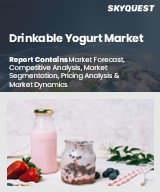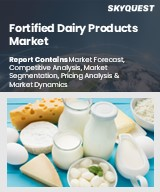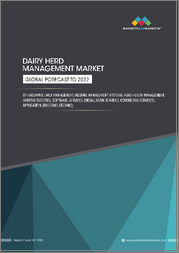
|
시장보고서
상품코드
1661590
미국의 유제품 시장 평가, 제품 유형별, 최종 용도 유형·용도별, 유통 채널별, 지역별, 기회 및 예측(2018-2032년)United States Dairy Market Assessment, By Product Type, By End-User Type/Application, By Distribution Channel, By Region, Opportunities and Forecast, 2018-2032F |
||||||
미국(US)의 유제품 시장은 2024년에 1,207억 달러로 평가되는 성숙 시장입니다. 2025-2032년의 예측 기간 중 CAGR은 4.21%에 달하며, 2032년에는 1,679억 달러에 달할 것으로 생각됩니다 미국에서는 건강에 대한 관심이 높아지고 1인당 소득이 증가함에 따라 특히 젊은 밀레니얼 세대와 Z세대 사이에서 고단백 식단에 대한 수요가 비례적으로 증가하고 있습니다. 유제품에는 우유 외에도 맑은 버터, 버터, 응유, 탈지분유, 탈지분유 등 부가가치 제품이 포함됩니다. 또한 아이스크림, 요구르트, 치즈, 유청 등 부가가치가 높은 현대식 유제품도 포함됩니다. 우유에는 칼슘, 단백질, 인, 비타민 등 유익한 성분이 함유되어 있으며, 일반적으로 매일 섭취하는 것이 좋습니다. 생산량 측면에서 젖소는 건조하고 서늘한 기후에서 자랍니다. 미국 젖소의 대부분은 홀스타인 품종으로 다른 품종에 비해 마리당 우유 생산량이 많습니다. 그러나 저지종과 교잡종 젖소는 홀스타인보다 유지방과 기타 우유 고형분을 더 많이 함유하고 있으며, 최근 들어 인기가 높아지고 있습니다.
제조용으로 지정된 원유는 대부분 치즈 제조에 사용됩니다. 치즈 제조의 제품별로는 유청이라는 물 같은 액체가 만들어집니다. 유청은 건조 유청, 유청 단백질 농축물, 유당 등을 제조하기 위해 추가 가공되는 경우가 많습니다. 치즈 수요의 확대는 미국 유제품 산업의 성장을 형성하는 주요 촉진요인 중 하나입니다. 치즈 소비량은 다양한 유형의 치즈가 출시되고, 가정 외 식사 증가, 치즈를 주재료로 하는 에스닉 요리의 인기 증가 등으로 인해 증가하고 있습니다. 우루과이라운드 무역협상의 결과로 1995년 1월 1일 세계무역기구(WTO)가 설립되었습니다. 미국 농무부(USDA)는 미국 유제품 산업을 규제, 지원, 촉진하고 있습니다. 미국 농무부의 낙농 관련 프로그램에는 연방 원유 판매 명령, 위험 관리 프로그램, 낙농 등급 및 기준, 낙농 연구 및 촉진 프로그램, 낙농 보상금 프로그램, 기부 프로그램, 다양한 식품 구매 프로그램 등이 있습니다.
목차
제1장 조사 방법
제2장 제품 개요
제3장 개요
제4장 고객의 소리
- 패키지 제품과 신선식품
- 브랜드 인지도와 로열티
- 구입 결정시 고려되는 요소
- 위생
- 품질
- 수량
- 가격
- 수량과 가격
- 오퍼와 디스카운트
- 저장 수명
- 맛 선호
- 영양가
- 리뷰와 권장사항
- 구입 빈도
- 구입 채널
- 시장 정보 분석
제5장 미국 유제품 시장 전망, 2018-2032년
- 시장 규모와 예측
- 금액별
- 수량별
- 시장 점유율과 예측
- 제품 유형
- 우유와 분유
- 치즈
- 크림
- 요구르트
- 버터
- 아이스크림
- 기타
- 최종 용도 유형·용도별
- 국내
- 산업
- 유통 채널별
- 온라인
- 오프라인
- 지역별
- 북동부
- 남부
- 서부
- 중서부
- 제품 유형
제6장 매크로 비즈니스 환경의 범위
- 밸류체인 분석
- 공급 수요 분석
- 수입 수출 분석
- 미국 유제품 시장의 PESTEL 분석
- 정치적 요인
- 경제 시스템
- 사회적 영향
- 기술의 진보
- 환경에 대한 영향
- 법령 준수와 규제기관
- Porter's Five Forces 분석
- 공급업체의 힘
- 바이어 힘
- 대체의 위협
- 신규 진출의 위협
- 경쟁 기업 간 경쟁 관계
제7장 주요 5사의 가격 포인트 분석
제8장 사례 연구(미국 유제품 시장의 기업이 채택한 베스트 프랙티스, 최대 3)
제9장 시장 역학
- 동향과 동향
- 성장 기회
- 성장 억제제
제10장 주요 기업의 상황
- 주요 5사 시장 기업 SWOT 분석
- 주요 5사 시장 리더의 경쟁 매트릭스
- 주요 5사 시장 리더 시장 매출 분석(%, 2024년)
- 합병과 인수/합병사업(해당하는 경우)
- 특허 분석(해당하는 경우)
제11장 주요 기업 전망
- Prairie Farms Dairy Inc.
- 회사 개요
- 주요 경영진
- 제품과 서비스
- 재무 상황(보고대로)
- 주요 시장에 대한 주력과 지역적 프레즌스
- 최근 동향
- Nestle USA
- Danone North America Inc
- Schreiber Foods, Inc.
- The Kraft Heinz Co.
- Foremost Farms USA Cooperative
- Land O'Lakes, Inc.
- California Dairies, Inc.
- Unilever United States, Inc.
- Dairy Farmers of America, Inc.
상기 기업은 시장 점유율에 따른 순위를 보유하지 않으며, 조사 작업 중 이용 가능한 정보에 따라 변경될 수 있습니다.
제12장 전략적 제안
제13장 조사회사 소개·면책사항
KSA 25.03.17The United States (US) Dairy Market is a matured market valued at USD 120.7 billion in 2024. The market will witness a CAGR of 4.21% during the forecast period between 2025 and 2032 and will be valued at USD 167.9 billion in 2032. With the rise in health-conscious consumers and higher per capita income in the US, there has been a proportionate rise in the demand for high-protein diets, particularly among younger millennials and generation Z. Dairy products include milk and value-added products such as clarified butter, butter, curd and skim milk powder. It also includes contemporary dairy products with added value like ice cream, yoghurt, cheese and whey. Since milk includes beneficial elements like calcium, protein, phosphorus, and vitamins, it is generally advised to consume it on daily basis. In terms of output, milk cows thrive in places with dry and cool weather. The majority of dairy cows in the US are Holsteins, a breed that produces more milk per cow than other breed of cows. Nonetheless, Jersey and crossbred cows have grown in favour in recent years because their milk contains higher quantities of milk fat and other milk solids than Holstein cows.
The majority of milk designated for manufacturing purposes is used to create cheese. As a byproduct of cheese production, a watery fluid known as whey is created. Whey is frequently processed further to produce items such as dry whey, whey protein concentrate, and lactose. Growing cheese demand has been one of key drivers shaping the growth of the US dairy industry. Cheese consumption has increased due to the availability of a wider range of cheeses, increased out-of-home eating, and increased popularity of ethnic cuisines that use cheese as a prominent ingredient. The Uruguay Round of trade negotiations resulted in the foundation of the World Trade Organization (WTO) on January 1, 1995. The US Department of Agriculture (USDA) regulates, assists, and promotes the US dairy industry. USDA's dairy-related programs include Federal Milk Marketing Orders, risk management programs, dairy grading and standards, dairy research and promotion programs, a Dairy Indemnity Payment Program, donation programmes, and different food purchasing programs.
Technology Involved in the US Dairy Market
The dairy business has seen considerable growth in the historical period between 2018 and 2032 owing to technology-driven goods, services and solutions. Some of the new age technologies that are helping in transformation of dairy market are supercooling technology, blockchain technology, synthetic dairy and robotic milking. Most advanced technology is robot milking because not only they complete the entire milking procedure automatically, but they also collect data to assist dairy producers in handling and deciding how to feed each cow in their herd.
Expansion of Baking Industry Boosts Market Growth
The rapid growth of the baking sector in the United States due to increasing preference for baked goods and confectionary products is propelling the market's expansion. As per the estimates of the American Bakers Association, the baking industry in the United States generates over USD 42 billion in direct wages, employs approximately 800,000 skilled professionals, and has an economic impact of almost USD 186 billion.
Additionally, as preference for indulgent and premium bakery items increases, the reliance on high-quality dairy products to enhance flavor and texture of the end-product also rises. The increasing popularity of artisanal and gourmet baked goods that contain rich dairy-based products is further increasing the reliance on the United States dairy market.
Specialty Dairy Products Demand is Expanding
The dairy business has been exclusively focused on milk from cows and buffaloes and milk-based products for many years. This established tradition has been overturned in the last few years by increasing internet usage and greater consumer awareness. Consumers today are moving more and more toward better and special products like particularly artisan cheese, that have seen significant growth in manufacturing over the previous years.
Trade Policies Supporting the Market Expansion
The value of commercial exports of the US dairy products has grown greatly since the mid-2000s. There were sporadic periods of significant dairy export activity before that, but they were often subsidized by the US Government. The US competes with other large dairy suppliers including New Zealand, the European Union (EU), and Australia. Free trade agreements (FTAs) with various countries have provided the US with greater access to the world markets. For instance, dairy exports to Mexico increased through the US-Mexico-Canada Agreement (USMCA), previously known as the North American Free Trade Agreement (NAFTA). USMCA replaced NAFTA on July 01, 2022.
Impact of COVID-19 on the US Dairy Market
In the early days and months of the COVID-19 pandemic, the dairy industry faced challenges-such as shifts in supply and demands food service demand fell and retail demand skyrocketed. However, the industry ultimately emerged with no significant adverse impact due to the adjustments done by the dairy producers such as portfolio simplification and manufacturing flexibility. The US Dairy Market witnessed a growth in demand in 2020 majorly across categories including an upward growth chart for fluid milk after four years.
The post pandemic trends seem promising in anticipation of an increase in social occasions where specialty cheeses are served. For yogurt, the main driver of the planned increase in purchases is likely commitment to health, including the link between live cultures and probiotics and their potential impact on the immune system.
Impact of Russia-Ukraine War on the US Dairy Market
The war has had a significant impact on the markets for commodities, particularly food and energy. The Russian invasion of Ukraine poses considerable upside pricing risks for agricultural, oil, and fertilizer commodities. These risks had led to increase in animal feed prices, feed supply and eventually farmgate milk prices. Another major impact on the US dairy industry was the increase in the milk products' packaging prices as the essential raw materials was supplied by the nations engaged in war.
Key Player Landscape and Outlook
The following major companies operating in the US Dairy market are thoroughly analysed regarding their product capabilities, value proposition offered, distribution channel, market shares and the most recent developments including inorganic growth strategies such as acquisitions & mergers and organic growth strategies such as production expansion. Furthermore, sustainability initiatives of the dairy companies are also included in the report. For instance, the food company Danone, which owns popular milk and yoghurt brands including Activia and Horizon Organics announced that it will reduce absolute methane emissions out of its milk supply chains by 30% making it the first leading food company to do so.
Table of Contents
1. Research Methodology
2. Product Overview
3. Executive Summary
4. Voice of Customer
- 4.1. Packaged Products vs Fresh Products
- 4.2. Brand Awareness and Loyalty
- 4.3. Factors Considered in Purchase Decision
- 4.3.1. Hygiene
- 4.3.2. Quality
- 4.3.3. Quantity
- 4.3.4. Price
- 4.3.5. Quantity wrt Price
- 4.3.6. Offers and Discount
- 4.3.7. Shelf Life
- 4.3.8. Taste Preferences
- 4.3.9. Nutritional value
- 4.3.10. Reviews and Recommendations
- 4.4. Frequency of Purchase
- 4.5. Channel of Purchase
- 4.6. Market Intelligence Analysis
5. United States Dairy Market Outlook, 2018-2032F
- 5.1. Market Size & Forecast
- 5.1.1. By Value
- 5.1.2. By Volume
- 5.2. Market Share & Forecast
- 5.2.1. By Product Type
- 5.2.1.1. Milk and Milk Powder
- 5.2.1.2. Cheese
- 5.2.1.3. Cream
- 5.2.1.4. Yoghurt
- 5.2.1.5. Butter
- 5.2.1.6. Ice Cream
- 5.2.1.7. Others
- 5.2.2. By End-User Type/ Application
- 5.2.2.1. Domestic
- 5.2.2.2. Industrial
- 5.2.2.2.1. Health and Wellness
- 5.2.2.2.2. Personal Care
- 5.2.2.2.3. Office Spaces
- 5.2.2.2.4. Educational Institutions/Hostels
- 5.2.2.2.5. HoReCa (Hotel, Restaurant and Cafe)
- 5.2.2.2.6. Others
- 5.2.3. By Distribution Channel
- 5.2.3.1. Online
- 5.2.3.2. Offline
- 5.2.3.2.1. Supermarkets/ Hypermarkets
- 5.2.3.2.2. Departmental Stores
- 5.2.3.2.3. Brand Stores/Kiosks
- 5.2.3.2.4. Others
- 5.2.4. By Region Type
- 5.2.4.1. Northeast
- 5.2.4.2. South
- 5.2.4.3. West
- 5.2.4.4. Midwest
- 5.2.1. By Product Type
6. Macro-Business Environmental Scope
- 6.1. Value Chain Analysis
- 6.2. Supply Demand Analysis
- 6.3. Import Export Analysis
- 6.4. PESTEL Analysis of United States Dairy Market
- 6.4.1. Political Factors
- 6.4.2. Economic System
- 6.4.3. Social Implications
- 6.4.4. Technological Advancements
- 6.4.5. Environmental Impacts
- 6.4.6. Legal Compliances and Regulatory Bodies
- 6.5. Porter's Five Forces Analysis
- 6.5.1. Supplier Power
- 6.5.2. Buyer Power
- 6.5.3. Substitution Threat
- 6.5.4. Threat from New Entrant
- 6.5.5. Competitive Rivalry
7. Price Point Analysis for Key Five Market Players
8. Case Studies (Best Practices Adopted by United States Dairy Market Players, Upto Three)
9. Market Dynamics
- 9.1. Trends & Developments
- 9.2. Growth Opportunities
- 9.3. Growth Inhibitors
10. Key Players Landscape
- 10.1. SWOT Analysis of Key Five Market Players
- 10.2. Competition Matrix of Key Five Market Leaders
- 10.3. Market Revenue Analysis of Key Five Market Leaders (in %, 2024)
- 10.4. Mergers & Acquisitions/ Joint Ventures (If Applicable)
- 10.5. Patent Analysis (If Applicable)
11. Key Players Outlook
- 11.1. Prairie Farms Dairy Inc.
- 11.1.1. Company Details
- 11.1.2. Key Management Personnel
- 11.1.3. Products & Services
- 11.1.4. Financials (As Reported)
- 11.1.5. Key Market Focus & Geographical Presence
- 11.1.6. Recent Developments
- 11.2. Nestle USA
- 11.3. Danone North America Inc
- 11.4. Schreiber Foods, Inc.
- 11.5. The Kraft Heinz Co.
- 11.6. Foremost Farms USA Cooperative
- 11.7. Land O'Lakes, Inc.
- 11.8. California Dairies, Inc.
- 11.9. Unilever United States, Inc.
- 11.10. Dairy Farmers of America, Inc.
Companies mentioned above DO NOT hold any order as per market share and can be changed as per information available during research work



















